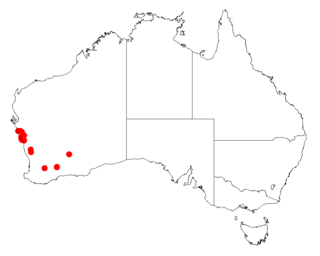
Acacia pycnantha, most commonly known as the golden wattle, is a tree of the family Fabaceae native to southeastern Australia. It grows to a height of 8 m (26 ft) and has phyllodes instead of true leaves. Sickle-shaped, these are between 9 and 15 cm long, and 1–3.5 cm wide. The profuse fragrant, golden flowers appear in late winter and spring, followed by long seed pods. Plants are cross-pollinated by several species of honeyeater and thornbill, which visit nectaries on the phyllodes and brush against flowers, transferring pollen between them. An understorey plant in eucalyptus forest, it is found from southern New South Wales and the Australian Capital Territory, through Victoria and into southeastern South Australia.

Acacia gunnii, commonly known as ploughshare wattle or dog's tooth wattle, is a woody shrub which is endemic to south-eastern Australia found in dry heaths and woodlands. It ranges from Queensland, then New South Wales, Australian Capital Territory, Victoria, South Australia, down to Tasmania. Acacia gunnii grows to up to 1 metre high and has prickly phyllodes which are 4 to 15 mm long. The cream to pale yellow globular flowerheads appear singly in the axils of the phyllodes in June to October, followed by curved or coiled seed pods which are 40 mm long and 4 to 5 mm wide. Acacia gunnii grows up to 1 meter tall and has prickly phyllodes which are 4 to 15mm in length with cream to pale-yellow globular flower heads appearing in phyllode axils in June through to October, followed by curved or coiled seed pods which are 40mm long and 4 to 5 mm wide. The species was first formally described by English botanist George Bentham in the London Journal of Botany in 1842. It occurs in South Australia, Victoria, Tasmania, New South Wales, Australian Capital Territory, and Queensland.

Acacia burkittii is a species of wattle endemic to Western Australia, South Australia and western New South Wales, where it is found in arid zones, and is a perennial shrub in the family Fabaceae. Common names for it include Burkitt's wattle, fine leaf jam, gunderbluey, pin bush and sandhill wattle. It has also been introduced into India. Previously this species was referred to as Acacia acuminata subsp. burkittii, but is now considered to be a separate species. Grows in mallee, eucalypt and mulga woodland or shrubland, often on sandhills.

Acacia arida, commonly known as arid wattle or false melaleuca, is a shrub belonging to the genus Acacia and the subgenus Juliflorae native to Western Australia.

Acacia filifolia is a shrub belonging to the genus Acacia and the subgenus Juliflorae that is endemic to western Australia.

Acacia leptophleba is a shrub belonging to the genus Acacia and the subgenus Juliflorae that is endemic to northern Australia.

Acacia sibirica, commonly known as bastard mulga or false witchetty bush, is a tree or shrub belonging to the genus Acacia and the subgenus Juliflorae. It is native to arid areas of Australia.

Acacia asperulacea is a shrub belonging to the genus Acacia and the subgenus Lycopodiifoliae.

Acacia baxteri, commonly known as Baxter's wattle, is a shrub belonging to the genus Acacia and the subgenus Phyllodineae, and is endemic to the south west of Western Australia.

Acacia bidentata is a shrub belonging to the genus Acacia and the subgenus Phyllodineae and is native to Western Australia.

Acacia oxyclada is a shrub belonging to the genus Acacia and the subgenus Phyllodineae that is endemic to western Australia.

Acacia dimidiata is a small tree belonging to the genus Acacia in the subgenus Juliflorae. It is native to northern Australia, being found in both in the Northern Territory, and Queensland. It is considered a species of least concern in the Northern Territory and Queensland.

Acacia simsii is a shrub belonging to the genus Acacia in the family Fabaceae. It is native to New Guinea and northern Australia. In Australia it is found in both the Northern Territory and Queensland.

Acacia scopulorum is a plant in the subgenus, Juliflorae, of the genus, Acacia in the family Fabaceae, endemic to the Northern Territory of Australia.

Acacia brachybotrya, commonly known as grey mulga or grey wattle, is a shrub belonging to the genus Acacia and the subgenus Phyllodineae that is endemic to Australia.

Acacia gladiiformis, commonly known as sword wattle or sword-leaf wattle, is a shrub belonging to the genus Acacia and the subgenus Phyllodineae that is native to parts of eastern Australia.

Acacia amanda is a shrub in the genus Acacia that is native to Northern Territory.

Acacia latzii, also known as Latz's wattle and Tjilpi wattle, is a shrubby tree of the genus Acacia. It is native to the Finke bioregion.

Acacia mimula is a tree in the genus Acacia. It is native to the Northern Territory, and found in open forest, from the Darwin region to western Arnhem Land.

Acacia yirrkallensis is a shrub of the genus Acacia and the subgenus Plurinerves. It is native to the top end of the Northern Territory.






















